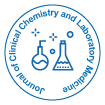
Journal of Clinical Chemistry and Laboratory Medicine
Open Access
ISSN: 2736-6588

ISSN: 2736-6588
Short Communication - (2021)Volume 4, Issue 10
Sequence-related amplified polymorphism is established on Open Reading Frames (ORFs) originated from genome sequence data of Arabidopsis. This molecular marker has been used for transcriptome map construction and comparative genome analysis of transcribed genes, which provides foundations for differential expression analysis at transcriptional level. SRAP markers show relatively more informative bands both at the DNA level and at the cDNA level, thus providing a more comprehensive indication of the degree of polymorphism in the genome.
Reverse primers; Amplicons; Sequences; Cdna; Polymorphisms
SRAPs provide a unique combination of forward and reverse primers which can be selected from a large number of primer combinations. It is the recently developed dominant marker technique [1]. Sequence-related amplified polymorphism is inexpensive, and effective for producing genome-wide fragments with high reproducibility and versatility. As this is an ORF-based marker system, it targets functional genes and has potential for their application in crop breeding. SRAPs have showed the ability to elucidate genetic variation at a variety of taxonomic levels. This marker system was first used by Li and Quiros in Brassica oleracea in 2001 and from then there have been several cases of using this in different plant species ranging from field crops for assessing genetic diversity, mapping and tagging of genes, hybrid identification and sex determination [2-6]. Many comparative studies have found SRAP markers provide corresponding levels of variation to AFLP markers, but with significantly less technical effort and cost for similar levels of band-pattern variability and reproducibility. These markers are new and their use is still in its early stages of its processing. Like other markers known as dominant, SRAP amplicons cannot yield heterozygosity (The presence of two different alleles at a particular gene locus) specification such as Hardy-Weinberg equilibrium. It is based on two-primer amplification. The primers are 17 or 18 nucleotides long and consist of the elements like core sequences, which are 13 to 14 bases long, where the first 10 or 11 bases starting at the 5′ end, are sequences of no specific constitution (“filler” sequences), accompanied by the sequence CCGG in the forward primer and AATT in the reverse primer. The core is having three nucleotides at the 3′ end. The filler sequences of the forward and reverse primers must be unique from each other and can be 10 or 11 bases in length. 35°C annealing temperature is set for the first five cycles [3,4]. Next following 35 cycles run at 50°C. The amplified DNA fragments are disconnected by denaturing acrylamide gels and it is detected by autoradiography. Marker technique is tested in a series of recombinant inbred and doubled-haploid lines of Brassica oleracea L. After sequencing, nearly 50 percent of the gel-isolated bands matched with genes in the Genbank database. Twenty percentages of the SRAP markers were co-dominant, which can be signified by sequencing. It also targets coding sequences in the genome and results in a many number of co-dominant markers [2-6]. The SRAP technique could detect polymorphisms arising from variants in the length of introns, promoters, and spacers, among both genotypes and species when different forward and reverse primers are randomly combined.
The size of the primer is significantly attached to the amplification of this system marker. SRAP is also a valuable approach to fingerprint cDNA. This method can obtain amplicons with good reproducibility and stability with good profits. This marker is combination of simplicity, reliability, moderate throughput ratio and facile sequencing of selected bands. Limitations of SRAP markers have not yet been described due to its new usage and its developing stage
Citation: Storm C (2022) Note on Sequence-Related Amplified Polymorphism as Novel Molecular Marker. J Clin Chem Lab Med. 4:192
Received: 27-Dec-2021 Accepted: 10-Jan-2022 Published: 17-Jan-2022
Copyright: © 2022 Storm C. This is an open-access article distributed under the terms of the Creative Commons Attribution License, which permits unrestricted use, distribution, and reproduction in any medium, provided the original author and source are credited.